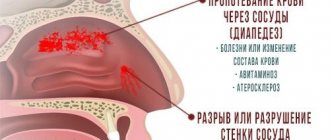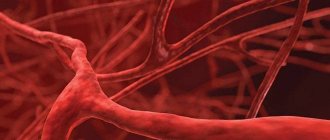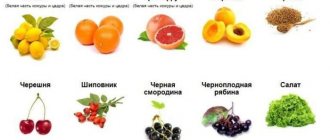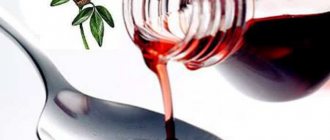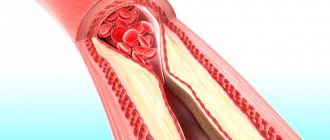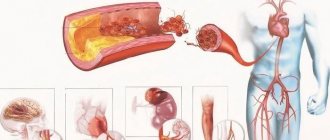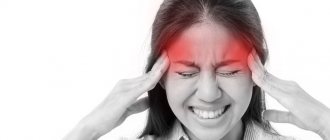Poor blood vessels are a disorder affecting a large percentage of the population. Modern man moves little, sits incorrectly, eats poorly, and smokes. The common denominator is pain, the cause of which is sought by either an orthopedic surgeon or a neurologist. But often the problem is a disorder of the blood vessels, not the musculoskeletal system.
Unfortunately, most people are unaware of their illness. Out of 100 people with symptoms of bad blood vessels, only 25 go to the doctor. Of course, the vascular system is quite branched and if part of the vascular tree is blocked or narrowed, the blood will “bypass” the obstacle through other branches. Despite this, patients with ischemic lower extremity disease should be considered at risk for possible negative consequences. If the blood vessels in the legs are damaged, most likely the arteries of the heart and brain will also not be in the best condition. Therefore, in case of leg pain, it is more than appropriate to consult a vascular surgeon or orthopedic surgeon because these two medical disciplines are closely related.
But why does weak blood vessels cause pain in the calves and sometimes in the thighs? It's simple. Legs are the most stressed part of the body when walking. Humans are at a disadvantage in this regard compared to animals due to verticalization. The vessels form veins and arteries. They are equally important, but each performs slightly different functions and the risks associated with them are different.
Bad veins
The most common problem for patients with poor blood vessels is chronic venous insufficiency, which leads to poor blood flow. This violation is quite easy to recognize. The main symptom of the disease is spasms in the calves even at rest, most often in the late afternoon. They may be accompanied by swelling of the lower leg.
The calves are painful while walking, but the pain does not go away even after stopping. One of the options for helping blood vessels and veins with venous insufficiency is raising the legs.
Despite its unpleasant symptoms, chronic venous insufficiency is not a dangerous disease.
Causes of the disease
There can be many reasons, because weak blood vessels are a complex symptom that can be identified by many factors.
For example, the first such consequence may be stress. A nervous state, disharmony and taking everything to heart lead to a similar problem. A sharp surge of adrenaline can weaken the heart and capillaries. An unbalanced and unhealthy diet leads to such problems.
There is such a factor as genetic predisposition. Some people are given vascular pain at birth. Also, after suffering from serious illnesses, weakening of blood vessels occurs. Leaving a healthy lifestyle leads to such a consequence of the body's reaction.
Bad arteries
Atherosclerotic artery disease is more severe. We are talking about ischemic disease of the lower extremities, when pain occurs when walking and is relieved even with a relatively short stop. A person feels typical pain, most often in the calves, sometimes in the thighs and buttocks. The soreness is usually described as similar to a dog bite.
In this disease, the arteries become narrowed or blocked, resulting in a disruption in the supply of oxygen and nutrients to the muscles. At a later stage of coronary artery disease, the legs hurt even at rest, especially at night.
Prevention
Given the high physical activity of children, curiosity and mobility, it is not possible to avoid mechanical injury to the eyes. However, it is possible to minimize the influence of factors that increase the likelihood of damage to the ocular vessels.
Preventive measures include:
- Limiting the time you use the computer and other gadgets. For children under 2 years old, it is better to exclude them. The total time spent at the computer should not exceed an hour per day. If a high school student's blood vessels burst after working with a computer, it is necessary to rest for 15 minutes after every hour, and it is also advisable to use safety glasses.
- Providing air humidification in the baby's nursery. It is recommended to ventilate and purchase an air humidifier.
- Compliance with eye hygiene measures to avoid inflammatory processes.
- Establishing a sleep schedule. The child should have a full night's sleep, this is especially true for older children.
- A balanced diet, including the vitamins and minerals necessary for a growing body. Vitamin C is especially important, as it is responsible for the elasticity and strength of blood vessels.
- Protect your eyes from direct sunlight.
According to everyone’s favorite pediatrician E. O. Komarovsky, the health of children depends 80% on the sanity of their parents. So that life does not deal blows, a young father and mother should not forget about basic prevention of capillary hemorrhages.
The essence of the events is:
to strengthen the body’s defense response, to exercise caution, and to ensure safe living conditions for the child.
Abuse of sweets, allergenic foods, sedentary lifestyle, lack of oxygen - these factors worsen the condition of blood vessels already in childhood. The child needs healthy eating and outdoor play.
| Vitamin C will be a good support for blood vessels. It strengthens them, increases elasticity, and the blood vessels become less fragile. |
Providing good lighting in the room where the child plays is essential. Limiting the time spent on the computer and filling your free time with active games as much as possible is also a good preventive measure.
Vascular diseases
One of the main causes of heart and blood vessel disease is the formation of cholesterol-containing deposits inside the coronary arteries. They can block blood vessels, reducing blood flow to the heart muscle.
The process of blockage of blood vessels (atherosclerosis) can begin already in a child. Its intensity and consequences depend primarily on nutrition. The process of vascular clogging can be significantly accelerated by high fat content in the diet, hypertension, diabetes, smoking, and lack of physical activity.
- Hypertension. Normal blood pressure is less than 140/90 mmHg. High blood pressure usually does not cause any symptoms. Despite this, the condition requires treatment. If left untreated, hypertension can lead to serious health problems.
- Heart attack. Blood carries oxygen to all parts of the body. When the arteries that supply oxygen to the heart are damaged (eg by atherosclerosis), the heart does not receive enough oxygen. A decrease in oxygen supply to the heart is manifested by chest pain - angina. When blood flow in the coronary arteries completely stops, a heart attack occurs.
- Atherosclerosis combined with hypertension can lead to myocardial infarction, angina, stroke and kidney damage.
- Stroke. High blood pressure causes the arteries to thicken, harden, and narrow. This process can damage the cerebral arteries. Damaged vessels become clogged or bleed, causing a stroke.
- Kidney damage. The kidneys act as a filter to remove waste from the body. Prolonged high blood pressure can damage this organ. The kidneys begin to work poorly and cleanse the blood less (that is, they do not sufficiently deprive it of metabolic waste). In this case, it is necessary to initiate artificial filtration (dialysis); in severe cases, kidney transplantation is performed.
General recommendations
- If you decide to go in for sports, it is better to start with small complexes of twenty minutes a day, but do them every day. Systematicity will lead to good results;
- If it is not possible to immediately start doing a contrast shower, then you can try contrast foot baths;
- It is worth eating fresh, healthy food in small portions and often, about 5-6 times a day;
- To clean the vessels, you need to drink two liters of fresh water a day.
Source: medic-23.ru
Signs of Problems
The human body has a system of warning signs that indicate the development of serious diseases. But the symptoms may not be noticeable. Therefore, if in doubt, it is advisable to visit a doctor.
Pain and numbness in the legs
Pain or numbness in the calves when walking may indicate compression or blockage of the arteries. Another feature of this condition is relief from pain or numbness after rest.
erectile disfunction
Many studies have shown that erectile dysfunction in men may be an indicator of impending cardiovascular disease. Therefore, it is preferable to consult a doctor to find out the cause of the problem rather than taking the blue pill.
Hair loss
Hair loss can mean high levels of triglycerides in the blood. Increased triglycerides (bad fat) can impede blood circulation and cause baldness in both men and women.
Wrinkling of earlobes
Diagonal wrinkling of the earlobes is not a definitive sign of vascular blockage. A person can be born with this sign. But along with other conditions such as age, weight and gender, it may be associated with an increased risk of coronary artery calcification.
By paying attention to these symptoms and visiting a doctor on time, you can save your life. Clogged blood vessels are a risk factor for heart disease.
What to do if blood vessels burst in the eyes?
Any changes occurring in the body require special attention, as do burst blood vessels. What to do if there is a hemorrhage in the eye:
- If a vessel rupture occurs due to physical stress, overwork, insomnia, or excessive alcohol intake, then it is enough to rest well or spend time in the fresh air. An excellent effect can be obtained if you use eye drops.
- Try not to go near the TV or computer for several days. If this is not possible, then you need to take breaks.
- Wash your face with cold water, which improves blood circulation and restores the eyeball.
- Cover your eyes with glasses when it is too sunny or windy outside.
- Ventilate the room, place bowls of water to increase air humidity, or purchase an air humidifier.
To increase the elasticity and firmness of blood vessels, you need to eat rationally, regularly take a multivitamin complex, avoid colds, and avoid any damage to the eyes. If the vessels periodically burst, then you should visit an ophthalmologist for a diagnostic examination.
Treatment and self-medication
To prevent and treat vascular problems, collaboration with a doctor is important, especially if you have hypertension or VSD. The first and main therapeutic method is nutritional adjustment, regardless of the use of vasodilator drugs.
Measures to lower blood pressure:
- nutrition adjustments;
- to give up smoking;
- regular movement, physical activity;
- mandatory rest after work;
- regular consultations with your doctor.
Improved nutrition
Reduce your salt intake. The average person consumes 10 grams of salt per day. The maximum recommended daily dose of salt is 5 g. This is approximately 1 tsp, including all salt in foods. A beneficial result of reducing the amount of salt will be a decrease in blood pressure and an improvement in the effects of antihypertensive medications.
How to normalize blood vessels by reducing salt intake:
- When cooking, use a minimum of salt. Remove the salt shaker from the dining table.
- Replace salt with spices, herbs, mushrooms.
- Include low-salt foods in your diet, such as fruits and vegetables. Eat them fresh.
- Monitor the salt content on food packages. Beware of canned food, semi-finished products, instant soups, processed cheese, and smoked foods. Potato chips, salted nuts, and ready-made sauces (soy, tartar) also have a high salt content.
- Scientists have proven that a diet with a predominance of vegetables, fruits, and low-fat dairy products can reduce blood pressure by 11 mmHg.
- Start your day with breakfast. The ideal way to tidy up your blood vessels is to have a breakfast of fruit, low-fat milk or yogurt.
- Fortify every meal with vegetables. Eat a fresh vegetable salad with yogurt dressing or cheese at every meal. Prepare steamed vegetables as a side dish. Add fresh or frozen vegetables to soups. Eat tomatoes, bell peppers, and grilled mushrooms.
- Don't skip snacks. Eat homemade yogurt and fresh fruit. Another good option to maintain vascular tone is fruits, unsalted nuts, hard cheese. A low-fat latte (coffee with 2/3 milk) is suitable as a drink, incl. cafein free.
- Whole grain cereals only. Discover the taste of whole grain bread, pasta, and natural rice.
- Eat healthy desserts. Sweet cravings can be satisfied with pieces of fresh or dried fruit. Also try a smoothie made with banana and low-fat milk.
Fats
One of the risk factors for heart disease is poor blood vessels. What to do to strengthen them? First of all, unsaturated fatty acids contained in vegetable oils and fish oil are important. They should make up about 2/3 of the fat consumed.
Only 1/3 of the fats should be saturated fatty acids, such as butter and dairy products, lard, pork, and beef. This amount is usually covered by the consumption of hidden fats (cream, cheese, smoked meats, baked goods), so when cooking, use only vegetable oils.
A favorable ratio of fat intake reduces the risk of cardiovascular disease.
Alcohol
The negative effects of excessive alcohol consumption are obvious (effects on the stomach, liver, pancreas, alcoholism...). It has been shown that regular consumption of small amounts of alcohol (1 can of beer, 100-200 ml of wine or 30-60 ml of strong alcohol) has a beneficial effect on the walls of blood vessels in healthy people and reduces pressure in the eyes. But in people with hypertension, the situation is the opposite - alcohol directly increases blood pressure, damages the walls of the arteries, making them thin, which makes treatment difficult.
To give up smoking
Nicotine vapors provoke constriction and narrowing of blood vessels, which increases blood pressure. Smoking contributes to the development of stroke and myocardial infarction. There is no “safe” dose of cigarettes. Even 1 cigarette a day doubles the risk of a heart attack. Long-term smoking reduces life expectancy by an average of 14 years. Nicotine also harms the health of others, incl. children.
Active movement
Along with drug treatment, movement is an important factor in preventing vascular disorders. The simplest advice is 30 minutes of daily walking (eg walking to work), which reduces the risk of heart and vascular diseases by 30%. Walk so fast that you can talk while walking, but not sing.
You can choose other physical activity, such as cycling, swimming, tennis, dancing. Move for at least 30 minutes every day. Working in the garden and cleaning the house also helps maintain healthy blood vessels.
Physical activity will provide better health, reduce fatigue, improve stress resistance, support heart function, lower blood pressure, body weight, and cholesterol concentrations.
If you have heart disease or have been inactive for a long time, it is best to talk to your doctor about a suitable sports program.
Relaxation
Excessive excitement and stress also harm blood vessels and the heart. Getting enough exercise and regular sleep will help you cope better with these situations. Relax, go into nature, read, engage in hobbies.
Visit your doctor regularly
The doctor will recommend how to treat vascular disorders. The therapeutic approach depends on blood pressure, age, other diseases such as excess weight, diabetes, heart disease, and medications taken.
A dietitian will help you adjust your diet according to your current condition.
Why might a capillary burst?
Over time, the walls of the blood vessels under the eyes become thinner and lose elasticity, which leads to rupture. A burst capillary turns into a bruise, and before starting treatment, the cause of the unpleasant phenomenon is determined.
Local reasons
The following factors cause vascular rupture:
- excessive external impact on the skin, trauma;
- hypersensitivity of the skin, close location of capillaries to the skin;
- sudden changes in temperature, including abuse of the sauna;
- improperly selected facial skin care – low-quality or inappropriate cosmetics;
- insufficient amount of moisture in the epidermis, excessive exposure to the sun, leading to dehydration, neglect of skin protection products from ultraviolet radiation;
- prolonged exposure to stress;
- alcohol and nicotine abuse;
- breastfeeding period, pregnancy, childbirth;
- excess body weight;
- The natural cause is physical aging of blood vessels.
Systemic pathologies
It is possible that the cause of burst vessels are pathological processes in the body:
- autoimmune system diseases;
- inflammatory and infectious diseases;
- allergy;
- cardiovascular pathologies;
- diseases of the gastrointestinal tract;
- cancerous tumors;
- consequences of chemotherapy;
- blood infection;
- intoxication and parasites;
- hormonal imbalance;
- meningitis.
If the bruises do not go away for a long time, visit a doctor for examination and treatment.
Now, knowing the reasons why the vessel ruptures and a hematoma forms, they take the next step - begin treatment.
At-risk groups
The risk group includes people with sensitive skin, pregnant and breastfeeding mothers, as well as patients suffering from diseases of the gastrointestinal tract, cardiovascular and endocrine systems, and liver.
Most often, weak blood vessels are found in people who lead a sedentary lifestyle and spend a lot of time at the computer, which is fraught not only with overstrain of the eye muscles and blood vessels, but also with a loss of elasticity of the capillaries due to impaired blood circulation. Also at risk are people who do not watch their weight and consume excessive amounts of alcohol and nicotine.
When vascular diseases destroy the brain
Older people are often besieged by potential diseases caused by poor vascular health. Some age-related diseases cause permanent brain damage.
The biggest concern for older people is dementia, the gradual loss of many brain abilities. 5-7% of people suffer from this disease after the age of 60 years. 1/5 of this group suffers from a type of dementia that has similar consequences. This is vascular dementia, the cause of which lies in the blood vessels of the brain.
Hardening of the arteries
Nerve cells in the brain need oxygen and nutrients from the blood. When the artery that supplies the brain with oxygenated blood is damaged, the cells that form the nerves die. Atherosclerosis develops, characterized by hardening of the arteries and the formation of blood clots. Weak blood vessels in the brain cause a number of minor strokes. This gradually enlarges the affected area of the brain, and symptoms of vascular dementia begin to appear.
Signs
With dementia caused by weak blood vessels in the brain, symptoms vary. The onset of their manifestation is quite rapid. But only a doctor can determine the exact disease. These signs are similar to those of similar diseases such as Alzheimer's disease.
Symptoms of vascular damage to the head and neck:
- problems with short-term and long-term memory, time perception;
- difficulty planning routine activities, such as shopping;
- impaired ability to manage money;
- night confusion;
- inability to concentrate;
- lack of recognition of people;
- failure to understand simple instructions and procedures, such as how to use a device or take a medication;
- gradual personality changes - increased aggression or, conversely, complete passivity;
- problems holding in urine and feces;
- speech problems;
- imbalance.
Symptoms of vascular dementia lead to a person’s lack of independence and loss of his own initiative.
Preventing Disease
Unfortunately, there are no traditional or specialized methods that can restore lost brain cells. The best thing you can do for brain health is to prevent disease.
If the brain is already affected by vascular dementia, but the disease is at an early stage, following these steps will help strengthen the blood vessels and prevent further deterioration of the disorder.
- Preventing or controlling diabetes. Diabetes can cause damage to blood vessels, so it is best to avoid the condition altogether. In its presence, proper compensation for the disease is required.
- Maintains cholesterol levels. Maintaining normal cholesterol levels will prevent atherosclerosis, i.e. narrowing and blocking of arteries.
- Hypertension is the enemy of blood vessels. Vascular dementia without high blood pressure is not observed. Uncontrolled hypertension can damage cerebral arteries.
- Regular brain training. At a critical age, starting from 60 years old, doing brain exercises is recommended. Regular solving of puzzles, counting examples, reading books, knitting is enough. A good way to train your brain is to interact with other people.
- Seeking help from a doctor. For thin vessels, treatment (changes in diet, use of medications) must be agreed with a doctor.
Folk remedies
Weak blood vessels were treated by our great-grandmothers. There are many popular recommendations for eliminating this disease.
- Before going to bed, you can drink a glass of water with a spoon of honey and lemon juice;
- In the morning it will be good to do various squats, stretching the legs and body, walks in the air and light jogging;
- You can also do a foot massage with your own hands. You should start from the fingers, ending with the hips;
- You can smear varicose veins with wild chestnut tincture. To do this, you need to collect chestnuts, crush them and pour vodka. Place in a dark place. After two weeks, the infusion is ready. Apply to problem veins twice a day. You can also make baths and lotions at night;
- Also try using a tincture of walnut, hawthorn, nettle, sea buckthorn oil and aloe;
- Garlic and cranberry juice are used twice a day in small portions for treatment and prevention;
- An effective way to get rid of many such problems is fasting. Such courses should be taken under the supervision of a doctor and at certain times of the year. First, you need to consult with a specialist, and then start with short fasts - three days. Gradually increasing to 21, and sometimes up to 40 days of complete abstinence from food.
